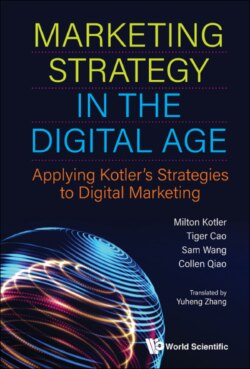Читать книгу Marketing Strategy In The Digital Age: Applying Kotler's Strategies To Digital Marketing - Milton Kotler - Страница 14
На сайте Литреса книга снята с продажи.
1.1 The Digital Environment
ОглавлениеWhen your CMO submits his annual marketing plan without any digital hint, maybe you should review the marketing strategies of the company to see whether a marketing revolution is needed in your company. Presentday entrepreneurs in any industry would probably agree that digitalized revolution is extremely urgent. “Revolutionary Panic” also prevails in traditional industries. If enterprises have not had digitalized transformation, they will face collapse in the next depression. Waves of digital marketing sweep through the society, because the current social environment is undergoing great changes: digitalization, like molecules, is penetrating every nook and cranny of modern society. And it is also the factor that enterprises in modernized business environments cannot be immune to. Consumers are willing to embrace the digital era; consumer-oriented enterprises are rapidly accelerating the pace of the “Internet+” to walk into the future of business (Figure 1.1).
Currently, business is entering the real-time age. The time taken for clients to make decisions, for the market to adjust to the competition landscape or for consumers to get a response used to be measured on a daily or hourly basis, but now, it is being calculated in minutes and seconds. The “Instance + Competitive advantage”, which seemed to be contradictory, is being considered as a pair. If enterprises do not respond to clients’ demand instantly at this moment, they are losing their clients and will fail in competition. “Instant connectivity” of mobile Internet makes the importance of user scenarios more prominent and “integrates people and machine into one”; community gathering makes crowdsourcing, crowd innovation and crowd promotion emerge in business models. Thinking models and organization incentive models are undergoing tremendous changes from strategy and operation to management. We need to redefine this era, redefine business and business models and redefine marketing strategies (Figure 1.2).
Figure 1.1. When customer age meets real-time age.
Source: Forrester Research.
Figure 1.2. Multi-screen interactions of consumers.
Source: Google, The New Multi-Screen World, 8/2012).
The New Multi-Screen World published on Google in 2012 shows that interactions happening on new digital media including cell phones, personal computers, tablets and TVs take up the majority of daily media interactions among consumers. Compared with traditional radio, newspapers and magazines, interactions on new media account for 90% of all media interactions. On average, people spend 4.4 hours on different types screens off work. A large part of the consumers’ time is occupied by the bit world. Recently, Nike has claimed that “Now each and everything is digital.” The best enterprises and institutions no longer just talk about digitalization alone but discuss it together with marketing for discussion. In the recent years of the “Internet+” wave, many enterprises’ chief information officers (CIO) claim to want to realize Internet-based and digital transition and change, attempting to complete the transition from information technology (IT) to digital technology (DT), while some start with revolutionizing the business model or the organizational structure. Among all of these means, the most efficient and operative one is “digital marketing strategy”, which is possible to be “value visualized” in real-time age. As Drucker proposed, marketing and innovation were the only sources of generating profit in enterprises. Without doubt, the digital marketing strategy will be discussed and is also the solution proposed by KMG (Figure 1.3).
Figure 1.3. Digital-first consumers.
Source: KMG Research.
In the age of revolution, it has always been consumers and markets that are one step ahead of enterprises. Great changes in the market propel the upgrading of competitions and “supply-side reform of enterprises”. At present, consumers have seen their lives being dominated by digital technologies, which penetrated consumption in purchasing and decisionmaking process. Such consumers include a new consumption group growing up with digital devices (such as people born in the 1990s and in the 2000s) and consumers who did not use digital media in the past but now do. An increasing number of consumers have found a “sweet spot” in waves of emerging technologies and have started to change the traditional consumption behavioral chain: 90% of people buy online. A total of 90% of people use multiple screens like personal computers, tablet computers, cell phones and TVs and jump from one node of the Internet to another. Around 65% of people shop online, which has led to the tremendous sales of Ali and JD, both being legends of IPO. About 61% of the people use social media on their cell phones and digital media like WeChat, Microblog, etc., which play a vital role in people’s social life. A total of 59% of the people attempted to manage wealth on smartphones: since Yu’E Bao in Alipay is bounded with Tianhong Asset Management, it instantly turns Tianhong from a small fund management into one of the largest players in China in asset management. Around 58% of the people use search engines when making personal wealth management decisions. As digital technologies have intruded and integrated into different industries and levels of consumers, tech and Internet have become as critical as “water and power” to business rather than a commercial tool or channel. Not to talk about them will take you away from consumers and away from the future.
Under the current digital age, new technologies emerge one after the other. Many upgraded technologies are seen in information exchange, client information and data storage, which have caused a new impact on traditional business environment. We conclude this as three key trends: digitalization of information exchange, digitalization of client interaction and digitalization of data storage (Figure 1.4).
Figure 1.4. Digital environment.
Source: KMG Research.
